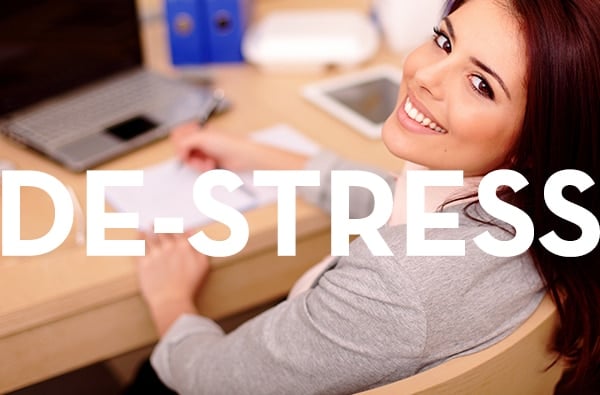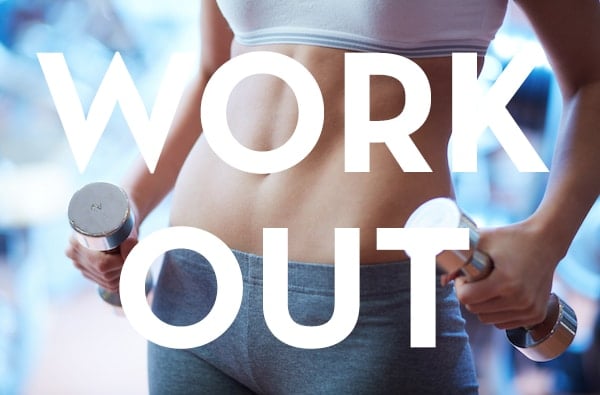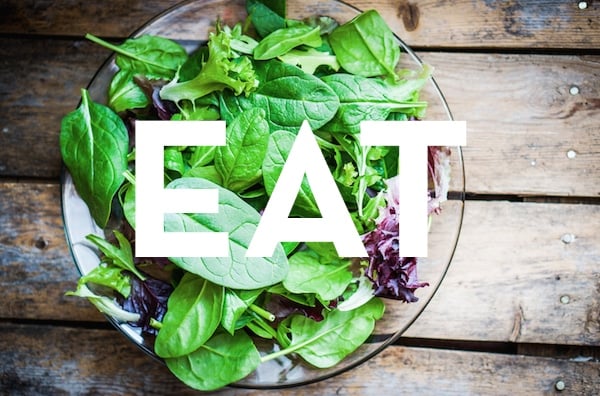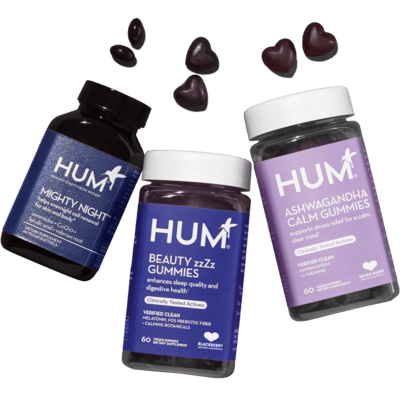Reclaim your New Year’s resolutions and accomplish your goals.
According to a recent HUM study, only eight percent of Americans followed through on their New Year’s resolutions, whether they’d set out to eat healthier, lose weight, or improve their fitness. “If you lack a foundation of meaning and relevance, even the most heartfelt resolutions will fall through,” says Laurie Gerber, co-president of Handel Group Life Coaching.
Keep reading to learn essential tips that’ll help you stick with your resolutions and achieve your health goals. Make this year the one during which your resolutions #startwithin.
1. Eat mindfully. Research has shown that multitasking while you eat can lead to overeating with extra calories that cause you to maintain or gain weight. Pick one meal each day where you pay attention to what you’re eating, rather than your phone or another screen. To make the habit even tinier, try: After my first bite at lunch, I’ll pay full attention to the taste, texture, and smell of how I am nourishing my body.
2. Take probiotics or digestive enzymes. Often, adding a probiotic or digestive enzyme blend into your diet can be beneficial for your gut health, reduce bloating, and support healthy digestion. You can even contact your HUM nutritionist to see if they’re right for you! Any daily habit from brushing your teeth in the morning to sitting down for lunch can serve as a reminder to take them.
3. Have a smaller portion size. In HUM’s study of 13,000 women on how habits link to waist size, we found that those who consistently chose smaller portions had a smaller waist size. Try grabbing a smaller plate, bowl, or glass so it’ll appear you’re eating more while you’re consuming just enough to satiate you.
4. Try this-for-that. Rather than denying yourself foods and limiting your diet, see where you can swap out this-for-that. For instance, a HUM study found that at 2:55 p.m., most women hit their daily energy slump, causing them to snack unhealthily with energy drinks or sugary treats. Swap out your unhealthy afternoon choices with HUM’s Raw Beauty green superfoods powder, packed with 39 detoxing greens and superfoods like chlorella, spirulina, kale, adaptogens, enzymes, and probiotics. Just mix it in your water bottle, morning smoothie, or almond milk at lunch to boost your energy and get radiant skin!
 1. Take microbreaks. Scheduling small rest breaks into your day boosts productivity, maintains energy, and helps reduce feelings of overwhelming stress. The “micro” part can be anything from a quick walk down the hallway to 10 deep, focused breaths.
2. Meditate for five minutes. Meditation has shown a range of de-stressing health benefits like reducing your stress response, preventing the negative effects of chronic stress, and lowering levels of cortisol. Falling into a routine of even five minutes a day can bring on serious benefits for overall wellness, state of mind, and health to achieve your resolutions.
3. De-screen. Using a moment in your day to actively avoid screens is especially powerful for your health goals in helping you sleep more restfully. Sleep loss releases more of the stress hormone cortisol, which can worsen stress and even age your skin. Take a moment to actively de-screen after you brush your teeth, before you hop in the shower, or after you change into your PJs.
4. Add adaptogens to your morning routine. Adaptogenic herbs are plants with evidence-based efficacy to increase tolerance of mental exhaustion, enhance attention and boost mental endurance in stressful situations. Adaptogens include rhodiola rosea found in HUM’s Big Chill, and ashwagandha and eleuthero in HUM’s Uber Energy for consistent adrenal support.
1. Take microbreaks. Scheduling small rest breaks into your day boosts productivity, maintains energy, and helps reduce feelings of overwhelming stress. The “micro” part can be anything from a quick walk down the hallway to 10 deep, focused breaths.
2. Meditate for five minutes. Meditation has shown a range of de-stressing health benefits like reducing your stress response, preventing the negative effects of chronic stress, and lowering levels of cortisol. Falling into a routine of even five minutes a day can bring on serious benefits for overall wellness, state of mind, and health to achieve your resolutions.
3. De-screen. Using a moment in your day to actively avoid screens is especially powerful for your health goals in helping you sleep more restfully. Sleep loss releases more of the stress hormone cortisol, which can worsen stress and even age your skin. Take a moment to actively de-screen after you brush your teeth, before you hop in the shower, or after you change into your PJs.
4. Add adaptogens to your morning routine. Adaptogenic herbs are plants with evidence-based efficacy to increase tolerance of mental exhaustion, enhance attention and boost mental endurance in stressful situations. Adaptogens include rhodiola rosea found in HUM’s Big Chill, and ashwagandha and eleuthero in HUM’s Uber Energy for consistent adrenal support.
 1. Schedule your workout. Go through your calendar and note the days in which you’ll work out. Seeing your workout marked in your calendar is a reminder that exercise isn’t a special treat for when you have the time; rather, it’s an important part of your day. Make sure you come up with an immediate consequence for breaking your promise to go to the gym, as well.
2. Lay out your sportswear. Seeing your clothes laid out ahead of time is a visual cue (and a bit of a guilt trip for getting you to hit the road, gym, or studio). Lay out your clothing after walking through the door, washing the dishes, or feeding the dog.
3. Track it. Keeping track of your workouts and progress over time can be a great way to boost motivation. However, the constant recordings can sometimes feel tedious, time-consuming and repetitive. To make tracking a tiny habit, commit to writing down just your miles after drinking your post-run water, snapping a gym selfie when you walk into the locker room, or tracking your calories in a fitness app after untying your laces. The numbers will begin to add up and your progress will be sure to inspire your commitment to your resolutions.
4. Incorporate fitness into your day. Take this one straight out of Fogg’s playbook: His first tiny habit was, After I pee, I’ll do two pushups.
Finally, subscribing for a monthly delivery of healthy vitamins and supplements so that you never run out is a convenient way to stick with your healthy resolutions. Check out the best nutrients for you, including the probiotics, digestive enzymes, and adaptogens mentioned above by taking our quiz and connecting with your free HUM nutritionist!
1. Schedule your workout. Go through your calendar and note the days in which you’ll work out. Seeing your workout marked in your calendar is a reminder that exercise isn’t a special treat for when you have the time; rather, it’s an important part of your day. Make sure you come up with an immediate consequence for breaking your promise to go to the gym, as well.
2. Lay out your sportswear. Seeing your clothes laid out ahead of time is a visual cue (and a bit of a guilt trip for getting you to hit the road, gym, or studio). Lay out your clothing after walking through the door, washing the dishes, or feeding the dog.
3. Track it. Keeping track of your workouts and progress over time can be a great way to boost motivation. However, the constant recordings can sometimes feel tedious, time-consuming and repetitive. To make tracking a tiny habit, commit to writing down just your miles after drinking your post-run water, snapping a gym selfie when you walk into the locker room, or tracking your calories in a fitness app after untying your laces. The numbers will begin to add up and your progress will be sure to inspire your commitment to your resolutions.
4. Incorporate fitness into your day. Take this one straight out of Fogg’s playbook: His first tiny habit was, After I pee, I’ll do two pushups.
Finally, subscribing for a monthly delivery of healthy vitamins and supplements so that you never run out is a convenient way to stick with your healthy resolutions. Check out the best nutrients for you, including the probiotics, digestive enzymes, and adaptogens mentioned above by taking our quiz and connecting with your free HUM nutritionist!
Take a Look at Your Habits
TINY HABITS & HABIT FORMATION
BJ Fogg, PhD, a Stanford innovator and psychologist, focuses his research on behavior change. In his theory on tiny habits, Fogg applies behavioral science to determine how to develop and stick to habits that allow you to achieve your goals. According to Fogg, rather than designing your resolutions around the outcome, lasting change occurs when you focus on the behaviors. Or rather, you focus on one behavior—a tiny aspect of that behavior—and little by little you achieve your desired outcome. For example, let’s say your resolution (outcome) is to lose weight. A variety of behaviors cause you to lose or not lose weight: calories consumed versus calories burned, your metabolism, stress factors, exercise, nutrients, etc. The attempt to tackle them all at once with the broad goal of losing weight is doomed for most people. Here’s why: According to Fogg, three things must occur at the same time in order to affect behavioral change.- Some level of motivation
- Some ability to do it
- A trigger or call to action
Set Up a System of Promises
“A resolution is vague and open-ended; a promise is clear and specific,” says Gerber. She gives these two examples:- This year, I’ll exercise more.
- Starting January 2, I’ll jog 30 minutes, four times per week—even on vacation.
How to Achieve your Resolution to…
Nourish Your Body.
Reduce Stress.
 1. Take microbreaks. Scheduling small rest breaks into your day boosts productivity, maintains energy, and helps reduce feelings of overwhelming stress. The “micro” part can be anything from a quick walk down the hallway to 10 deep, focused breaths.
2. Meditate for five minutes. Meditation has shown a range of de-stressing health benefits like reducing your stress response, preventing the negative effects of chronic stress, and lowering levels of cortisol. Falling into a routine of even five minutes a day can bring on serious benefits for overall wellness, state of mind, and health to achieve your resolutions.
3. De-screen. Using a moment in your day to actively avoid screens is especially powerful for your health goals in helping you sleep more restfully. Sleep loss releases more of the stress hormone cortisol, which can worsen stress and even age your skin. Take a moment to actively de-screen after you brush your teeth, before you hop in the shower, or after you change into your PJs.
4. Add adaptogens to your morning routine. Adaptogenic herbs are plants with evidence-based efficacy to increase tolerance of mental exhaustion, enhance attention and boost mental endurance in stressful situations. Adaptogens include rhodiola rosea found in HUM’s Big Chill, and ashwagandha and eleuthero in HUM’s Uber Energy for consistent adrenal support.
1. Take microbreaks. Scheduling small rest breaks into your day boosts productivity, maintains energy, and helps reduce feelings of overwhelming stress. The “micro” part can be anything from a quick walk down the hallway to 10 deep, focused breaths.
2. Meditate for five minutes. Meditation has shown a range of de-stressing health benefits like reducing your stress response, preventing the negative effects of chronic stress, and lowering levels of cortisol. Falling into a routine of even five minutes a day can bring on serious benefits for overall wellness, state of mind, and health to achieve your resolutions.
3. De-screen. Using a moment in your day to actively avoid screens is especially powerful for your health goals in helping you sleep more restfully. Sleep loss releases more of the stress hormone cortisol, which can worsen stress and even age your skin. Take a moment to actively de-screen after you brush your teeth, before you hop in the shower, or after you change into your PJs.
4. Add adaptogens to your morning routine. Adaptogenic herbs are plants with evidence-based efficacy to increase tolerance of mental exhaustion, enhance attention and boost mental endurance in stressful situations. Adaptogens include rhodiola rosea found in HUM’s Big Chill, and ashwagandha and eleuthero in HUM’s Uber Energy for consistent adrenal support.
Get enough exercise.
 1. Schedule your workout. Go through your calendar and note the days in which you’ll work out. Seeing your workout marked in your calendar is a reminder that exercise isn’t a special treat for when you have the time; rather, it’s an important part of your day. Make sure you come up with an immediate consequence for breaking your promise to go to the gym, as well.
2. Lay out your sportswear. Seeing your clothes laid out ahead of time is a visual cue (and a bit of a guilt trip for getting you to hit the road, gym, or studio). Lay out your clothing after walking through the door, washing the dishes, or feeding the dog.
3. Track it. Keeping track of your workouts and progress over time can be a great way to boost motivation. However, the constant recordings can sometimes feel tedious, time-consuming and repetitive. To make tracking a tiny habit, commit to writing down just your miles after drinking your post-run water, snapping a gym selfie when you walk into the locker room, or tracking your calories in a fitness app after untying your laces. The numbers will begin to add up and your progress will be sure to inspire your commitment to your resolutions.
4. Incorporate fitness into your day. Take this one straight out of Fogg’s playbook: His first tiny habit was, After I pee, I’ll do two pushups.
Finally, subscribing for a monthly delivery of healthy vitamins and supplements so that you never run out is a convenient way to stick with your healthy resolutions. Check out the best nutrients for you, including the probiotics, digestive enzymes, and adaptogens mentioned above by taking our quiz and connecting with your free HUM nutritionist!
1. Schedule your workout. Go through your calendar and note the days in which you’ll work out. Seeing your workout marked in your calendar is a reminder that exercise isn’t a special treat for when you have the time; rather, it’s an important part of your day. Make sure you come up with an immediate consequence for breaking your promise to go to the gym, as well.
2. Lay out your sportswear. Seeing your clothes laid out ahead of time is a visual cue (and a bit of a guilt trip for getting you to hit the road, gym, or studio). Lay out your clothing after walking through the door, washing the dishes, or feeding the dog.
3. Track it. Keeping track of your workouts and progress over time can be a great way to boost motivation. However, the constant recordings can sometimes feel tedious, time-consuming and repetitive. To make tracking a tiny habit, commit to writing down just your miles after drinking your post-run water, snapping a gym selfie when you walk into the locker room, or tracking your calories in a fitness app after untying your laces. The numbers will begin to add up and your progress will be sure to inspire your commitment to your resolutions.
4. Incorporate fitness into your day. Take this one straight out of Fogg’s playbook: His first tiny habit was, After I pee, I’ll do two pushups.
Finally, subscribing for a monthly delivery of healthy vitamins and supplements so that you never run out is a convenient way to stick with your healthy resolutions. Check out the best nutrients for you, including the probiotics, digestive enzymes, and adaptogens mentioned above by taking our quiz and connecting with your free HUM nutritionist!
More like this










